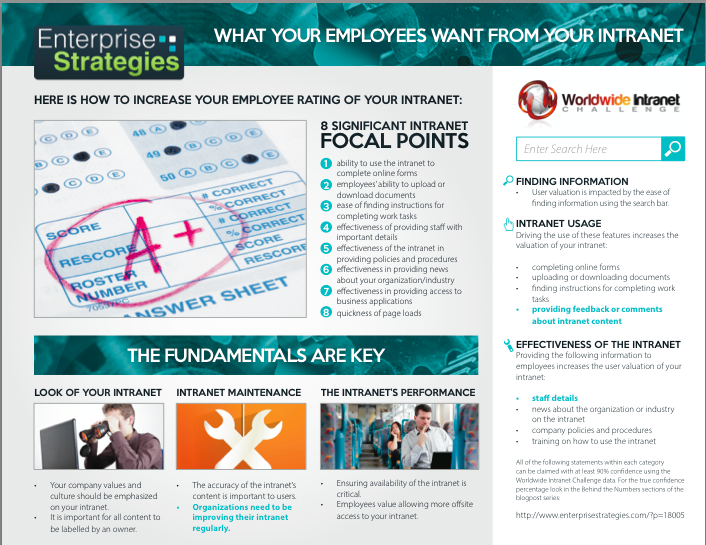Co-Author Tyler Sauerteig
[vc_separator type=’transparent’ position=’center’ color=” thickness=’5′ up=” down=”]
In partnership with the Worldwide Intranet Challenge, we’ve applied econometric principles to the results of over 200 intranet surveys and statistically pinpointed which intranet attributes most impact a user’s perception of their intranet. This third post in this seven week series is focused on the data analysis of “intranet usage” factors — showing which intranet usage activities have the biggest impact on how employees view their company’s intranet.
[vc_separator type=’transparent’ position=’center’ color=” thickness=’10’ up=” down=”]
Confirming the Basics
[vc_separator type=’transparent’ position=’center’ color=” thickness=’15’ up=” down=”]
There are certain basic things employees have come to expect to be able to do on an intranet (e.g., reading company news). In this study, we dug a little deeper to see if we could identify which basic usage functions had the biggest positive impact on a employee’s valuation of their intranet. With 99+% confidence, we can conclude that:
[vc_separator type=’transparent’ position=’center’ color=” thickness=’5′ up=” down=”]
[vc_separator type=’transparent’ position=’center’ color=” thickness=’10’ up=” down=”]
 Free Download: What Your Employees Want From Your Intranet
Free Download: What Your Employees Want From Your Intranet
[vc_separator type=’transparent’ position=’center’ color=” thickness=’2′ up=” down=”]
In this download, you will find the following information:
- Ways to increase your employees’ rating of your company’s intranet
- How to invest your intranet redesign money to get the biggest return
- Key intranet fundamentals to ensure employee engagement
[vc_separator type=’transparent’ position=’center’ color=” thickness=’5′ up=” down=”]
[button size=” style=” text=’Get Your Free Download’ icon=” icon_color=” link=’/what-your-employees-want-from-your-intranet/’ target=’_self’ color=” hover_color=” border_color=” hover_border_color=” background_color=” hover_background_color=” font_style=” font_weight=” text_align=” margin=”]
[vc_separator type=’transparent’ position=’center’ color=” thickness=’30’ up=” down=”]
The more often employees use their intranet to do these three things, the higher their overall valuation of their intranet:
[vc_separator type=’transparent’ position=’center’ color=” thickness=’5′ up=” down=”]
- Complete online forms
- Upload or download documents
- Find instructions for completing work tasks
[vc_separator type=’transparent’ position=’center’ color=” thickness=’10’ up=” down=”]
Proving the Case for a Social Intranet?
[vc_separator type=’transparent’ position=’center’ color=” thickness=’5′ up=” down=”]
For the last three years (if not more), software companies and social business advocates (self included) have been preaching the benefits and importance of making intranets “social”. In other words, providing users that ability to both post content and comment on others’ posts. Without getting into the pros in cons in this post, let’s just say that if we take in aggregate both social advocates and the more traditionally minded (and risk concerned) old guard … there is a “house divided”. Again, we set out to dig deeper using the power of econometrics and see if we could show the impact of social activity on an employee’s valuation of their company’s intranet. With 94% confidence, we can conclude that:
[vc_separator type=’transparent’ position=’center’ color=” thickness=’5′ up=” down=”]
The more often employees use their intranet to provide feedback or comments about intranet content, the higher their overall valuation of their intranet.
[vc_separator type=’transparent’ position=’center’ color=” thickness=’5′ up=” down=”]
These findings are based on Worldwide Intranet Challenge survey participants rating the importance of the following statements about the “their usage” of their company’s intranet.
[vc_separator type=’transparent’ position=’center’ color=” thickness=’5′ up=” down=”]
- Complete common work tasks such as applying for leave
- Complete online forms
- Publish content
- Upload or download documents
- Discuss work topics (eg. using discussion forums or blogs)
- Collaborate with other staff (eg. using online work spaces)
- Find instructions for completing work tasks
- Provide feedback or comments about intranet content
[vc_separator type=’transparent’ position=’center’ color=” thickness=’10’ up=” down=”]
Very Few Studies Are Perfect
[vc_separator type=’transparent’ position=’center’ color=” thickness=’5′ up=” down=”]
We are making some big statements with this study, and while we are confident in the numbers, it is important that these statements are taken in the appropriate context. This particular analysis is showing that the more often employees use their intranet to provide feedback or comments about intranet content, the higher their overall valuation of their intranet. And we are taking that to mean that this “social” feature is positively impacting a employee’s valuation of their company’s intranet. But what about the other “social” features listed, namely, “discussing work topics” and “collaborating with other staff” … why didn’t these activities score higher? Well, one reason could be that the Worldwide Intranet Challenge started benchmarking intranets as early as 2009. How many intranets actually had the ability to discuss work topics and collaborate with staff five years ago? Another reason could be that companies generally tend to benchmark their intranets either prior to, or immediately after, a redesign. If the majority of companies benchmarked fall into the former category, it is unlikely that their intranets (at the time of the survey) had advanced social features. Both of these potential reasons lead me to believe that if our data set included more companies with intranets providing the ability to discuss work topics and collaborate with staff, these activities would have also scored high — providing further evidence that the more employees use the social features of their company’s intranet, the higher overall value they assign to it. Only time will tell. That said, it is our hope that by doing the best we could with the data available we have helped provide
[vc_separator type=’transparent’ position=’center’ color=” thickness=’5′ up=” down=”]
“some solid quantitative evidence to support where companies should invest when completing an intranet redesign.”
[vc_separator type=’transparent’ position=’center’ color=” thickness=’5′ up=” down=”]
We hope you are finding this study useful and look forward to your comments. We are fortunate to have had some top intranet experts weigh in on our evaluation of intranet “Look Factors” ... here’s to another great discussion.
[vc_separator type=’transparent’ position=’center’ color=” thickness=’5′ up=” down=”]
To see the details on how we came to the above conclusions, please grab a (strong) cup of coffee and read the following section.
[vc_separator type=’transparent’ position=’center’ color=” thickness=’10’ up=” down=”]
Behind the Numbers
[vc_separator type=’transparent’ position=’center’ color=” thickness=’5′ up=” down=”]
For this category, we had to correct our equation for the heteroskedasticity within our model and we did so using White Heterosekdasticity-Consistent Standard Errors & Covariance. Heteroskedasticity causes the standard errors to be biased which leads to unreliable hypothesis testing. By using the consistent standard errors, we take a large amount of the bias out of the standard errors and our p-values are much stronger than they are with the regular estimation output. Heteroskedasticity does not bias the coefficients but the standard errors, so changing to standard errors helps our estimates greatly,and further limits our chance of error in our confidence levels. By using this corrected equation, all econometric problems are accounted for.
[vc_separator type=’transparent’ position=’center’ color=” thickness=’5′ up=” down=”]
Statement Coefficient P-Value
Complete common work tasks such as applying for leave 0.083 0.230
Complete online forms 0.227 0.002
Publish content 0.047 0.534
Upload or download documents 0.322 0.000
Discuss work topics (eg. using discussion forums or blogs 0.010 0.897
Collaborate with other staff (eg. using online work spaces) -0.077 0.302
Find instructions for completing work tasks 0.207 0.0025
Provide feedback or comments about intranet content 0.149 0.059
Adjusted- R²: 0.491
The adjusted-R² tells us that 49.1% of the variance in the valuation of the intranet in the WIC data is described by the statements within the category of “how often you use the intranet to”.
The statements that we found to be most important to your employees based on how often intranet usage to do certain things were: completing online forms, uploading or downloading documents, finding instructions for completing work tasks, and providing feedback or comments about intranet content.
[vc_separator type=’transparent’ position=’center’ color=” thickness=’5′ up=” down=”]
- With 99+% confidence, we can conclude that using the intranet more often to: complete online forms, upload or download documents, and find instructions for completing work tasks all increase the valuation ranking that your company’s intranet received.
- With 94% confidence we can conclude that how often you use the intranet to provide feedback or comments about intranet content increases the valuation ranking that your company’s intranet received.
[vc_separator type=’transparent’ position=’center’ color=” thickness=’10’ up=” down=”]
Interpretation of the Coefficient:
[vc_separator type=’transparent’ position=’center’ color=” thickness=’5′ up=” down=”]
- When looking only at the how often I use the intranet to statements, given your answer to the WIC statement “providing feedback or comments about intranet content” was ranked one rating higher (better) in the WIC ranking system for that statement, the way that you were ranked in the valuation question “In general, I would rate the intranet as” was on average 0.149 ranks higher (better), holding all other variables constant.
[vc_separator type=’transparent’ position=’center’ color=” thickness=’5′ up=” down=”]
When looking at the data, even though they are not statistically significant, the variables dealing with collaboration are both negative. This is something to consider when building your intranet, but it is something beyond the intranet build that needs to be considered. Your employees still do not consider collaboration and discussion of work topics as important as those who adopt these internal networks and preach collaboration believe it should be. This is an issue greater than the intranet–it is something that needs to be continually preached within the company so that people are using the intranet to collaborate and become more efficient within the business. Your intranet needs to get to the point where your employees can really see the business value from collaboration on work topics.
Engagement based on intranet usage is something that you are really looking to provide to your employees. Therefore what makes your employees value your intranet highest, based on how often they are using it to do specific things, is vital to your intranet build and what kind of content you focus on. Our next blog post will be on the category of rating the intranet based on the effectiveness in providing specific aspects vital to your business and what aspects your employees find most important in their valuation.
[vc_separator type=’transparent’ position=’center’ color=” thickness=’5′ up=” down=”]




